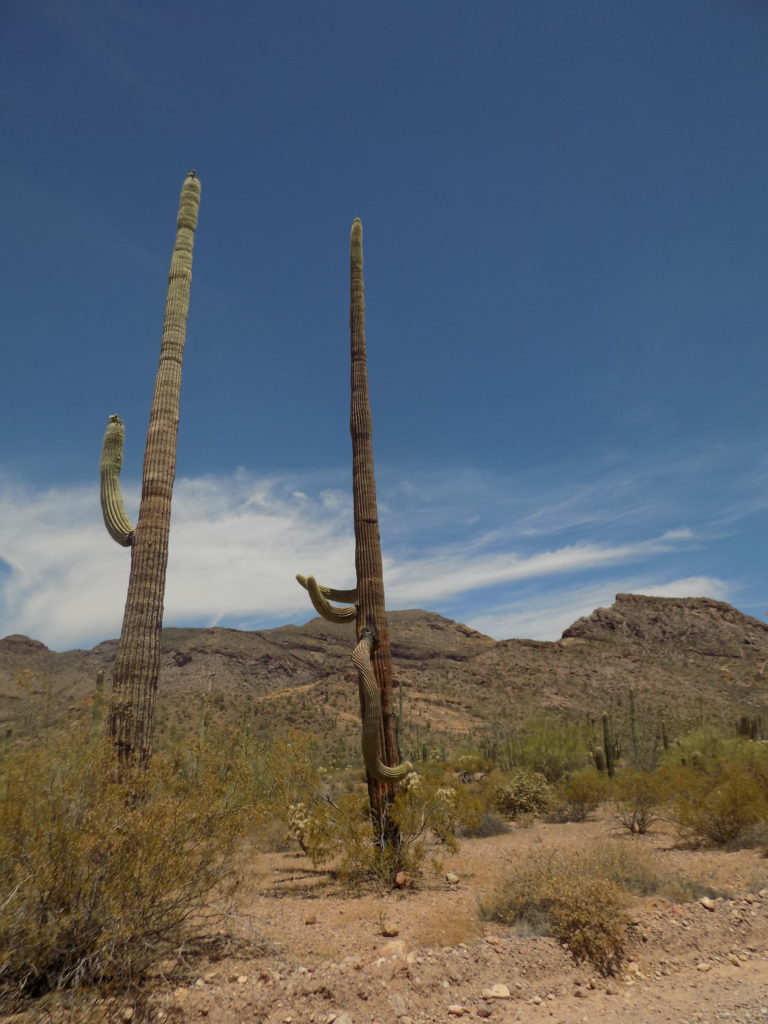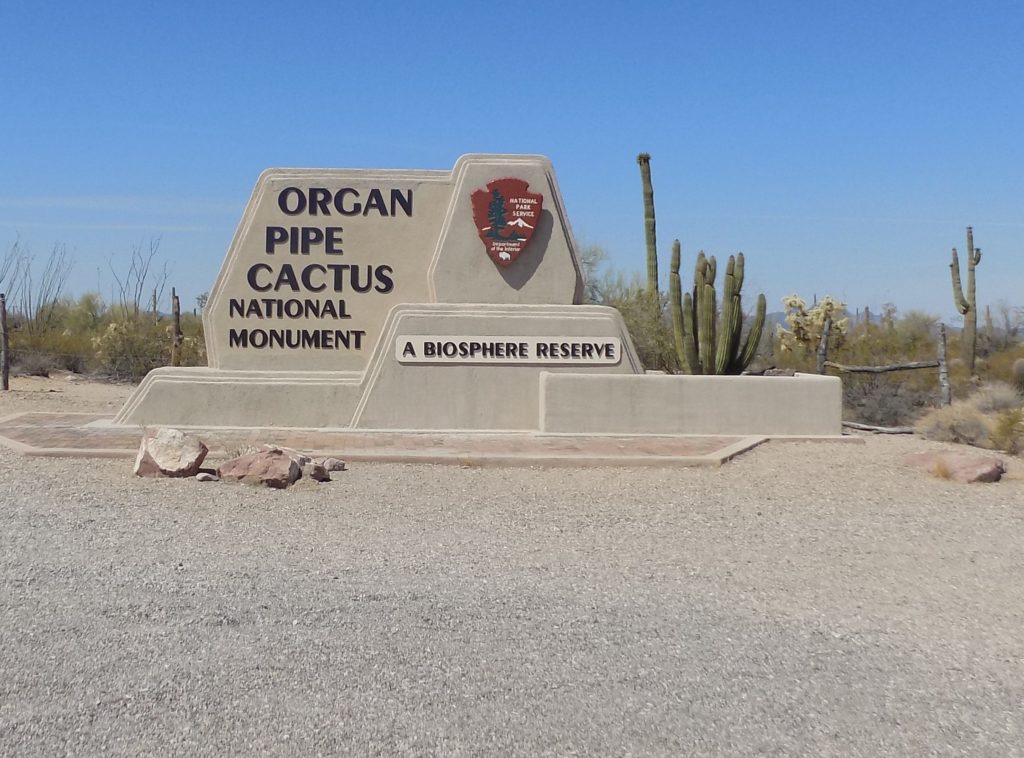Although Tucson sits at only 2,400 feet in altitude, I woke up on morning two with a mild headache and dryness in my nose that felt more intense than the effects of a potent antihistamine – symptoms that would typify my mornings on this journey. The higher the altitude and drier the air, the more pronounced this early morning discomfort became. Fortunately, the symptoms usually dissipated quickly as I set about my day’s activities and disappeared entirely shortly thereafter.
The primary item on my agenda, and one of the reasons I chose to start this trip in Tucson, was to visit Organ Pipe Cactus National Monument. And why, you might wonder, would I be interested visiting this rather out of the way place? (Of course, people often wonder why I choose to visit many of the places I do.) The main reason is that the organ pipe cactus grows in a relatively limited geographic range and it’s quite different from the more commonly seen saguaro cactus. Fortunately, Organ Pipe is an ideal place to see impressive stands of both species.
In the photo above, you can see two saguaros – one at the right edge and a tall armless plant behind the multi-limbed organ pipe. While it’s possible to see the occasional organ pipe in other places in the Sonoran Desert, it’s likely that it’s a transplant. Although the organ pipe’s range extends far south into Mexico, this national monument is the only place to see large stands of these cacti in the United States. Secondarily, this part of Arizona is a place where visitors from the eastern states aren’t likely to go and unlikely places are often my favorites.
The drive from Tucson to Organ Pipe is uncomplicated. You hop on State Route 86 west (Ajo Way) and drive until the road’s end about 120 miles later. Then head south on Route 85 (Puerto Blanco Drive). You reach the sign in the photo above in five miles or so but need to continue for another 15 or 20 miles until you reach the Kris Egge Visitor Center. (There’s a small memorial to Kris Egge a Park Ranger who died “while protecting visitors from harm.”)
Along the way, you’ll enter the Tohono O’Odham Nation, pass Kitt Peak Observatory and the town of Why.
 . I’d planned on the drive taking about two and a half hours but that proved not to be the case.
. I’d planned on the drive taking about two and a half hours but that proved not to be the case.
I didn’t know, for example, that on these roads, you’re almost certain to pass through one or more border patrol checkpoints. Fortunately, these delays proved minimal. (You’ll also see a regular stream of green and white border patrol vehicles cruising the highways.) The real delays arose when I encountered areas of road construction that constricted the two-lane road to one and, shall I say, measurably slowed my progress. However, an accidental discovery that made the delays easier to abide, soon became a major disappointment.
Until that morning, I hadn’t noticed that my rental car was equipped with Sirius XM radio but, while idling at one of these delays, I inadvertently touched the satellite button. Much to my surprise it worked! What a pleasure it would be to have satellite radio for the duration. As it turned out, this was not to be the case. I’d simply tuned in to a Sirius XM promotional free weekend. Disappointment arose a few days later when my radio again became earthbound.
Although I paid it little heed at the time, it was also in Organ Pipe that I got the first indication that I should be cautious in relying on my phone’s GPS and navigation. As I pulled-in to the visitor’s center, I received a text from T-Mobile informing me that I wouldn’t have to pay roaming charges while I was in Mexico. This would have been good news had I actually been in Mexico but I was still about six miles north of the border crossing at Lukeville. Now, let’s take a more detailed look at some of the desert flora I got to see closeup and that you can see in these photos.
The largest cactus growing in the United States
I’ll start with the saguaro as one of the iconic features of the flora of the region. It’s found almost exclusively in the Sonoran Desert with a range that makes it the “ooh-ah” (explained here) of northern Mexico and Southern Arizona. Saguaros are very slow growing plants and a 10-year-old saguaro might only be 1 to 2 inches tall. On the other hand, saguaro generally live to 170-200 years and typically grow to be between 40-60 feet tall.
About 70 years into its life cycle, the height of the plant will have reached about six feet and it will begin to flower. Twenty years or so years after that, saguaros will develop their arms. Or not. Biologists don’t know why some of these cacti grow arms and others don’t. Sometimes, rather than the arms pointing upward, you see saguaros with their arms bent at odd angles
 such as the one on the right in this photo. Here’s why:
such as the one on the right in this photo. Here’s why:
Most of the root system of the saguaro is only 4-6 inches deep but radiates out as far from the plant as it is tall. There is one deep root or tap root that extends down into the ground to a depth of two to four feet and although the Sonoran Desert experiences both winter and summer rains, it’s thought that the Saguaro obtains most of its moisture – which it wisely stores to survive through the dry seasons – during the summer rainy season and not during the winter.
The skin of the saguaro cactus is covered with a thick waxy coating that waterproofs the plant, and reduces water lost to the air through transpiration. The spines provide additional protection. The interior of the cactus is filled with a sponge-like tissue, which is used to hold most of the water the cactus collects. At full capacity, a single foot of saguaro cactus can weigh upwards of 90 pounds, and a fully hydrated plant can weigh more than two tons.
When water freezes, it has a nasty habit (if you’re a saguaro) of contracting. The stored water will do just that during a hard freeze and, if the thaw comes too quickly, the plant’s arm can break and will bend down. Then, as the plant attempts to repair itself and begins to grow again, you see the end of the arm start to turn up thus creating some of those twisted shapes.
One last point of interest about the saguaro concerns the way the local Tohono O’Odham people view it. To them, these giant cacti are not plants but are a different type of humanity. They are thus viewed as respected members of the Tohono O’Odham Tribe.
Music of the organ pipe cactus.
Although it’s the second largest North American cactus, the organ pipe has adopted a different survival and reproductive strategy from its larger neighbor and the difference begins with the nascent plant. While the saguaro will use palo verde, ironwood, or mesquite trees as nurse trees, the organ pipe may or may not grow with such a companion. (A nurse tree is a larger, faster-growing tree that shelters a small, slower-growing tree by sometimes providing shade, shelter from wind, or protection from animals that would feed on the smaller plant.)
While the early Spanish explorers called this plant pitaya dulce or sweet cactus fruit, one look at its configuration is all that’s needed to understand the source of its common English name. The plant in the photo above is about as fulsome an organ pipe as you’re likely to see. I counted at least 17 stems and the species usually maxes out at twenty. The stems you see are fairly narrow – about six inches thick – and grow vertically from a single trunk just above ground level. They generally peak at about 16 feet in height but will sometimes grow as tall as 25 feet.
My look at the organ pipe cactus continues in the next post.

